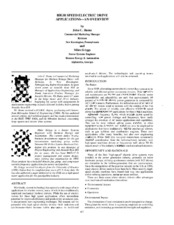| dc.contributor.other | Turbomachinery Symposium (26th : 1997) | |
| dc.creator | Rama, John C. | |
| dc.creator | Griggs, Miles | |
| dc.date.accessioned | 2017-10-05T14:06:23Z | |
| dc.date.available | 2017-10-05T14:06:23Z | |
| dc.date.issued | 1997 | |
| dc.identifier.uri | https://hdl.handle.net/1969.1/163424 | |
| dc.description | Tutorial | en |
| dc.description | pg. 167-176 | en |
| dc.description.abstract | Worldwide, current technology has opened a wide range of new applications for electric motors, many of which have traditionally employed mechanical (turbine) drivers. While the use of electric motors for these high speed applications offers tremendous potential for improved efficiency and productivity at reduced cost, it also presents new engineering challenges. The reasons will be presented why high speed electric drivers-both induction and synchronous-have become viable alternatives to traditional mechanical drivers. The technologies and operating issues involved in such applications will also be reviewed. | en |
| dc.format.medium | Electronic | en |
| dc.format.mimetype | application/pdf | |
| dc.language.iso | en | |
| dc.publisher | Texas A&M University. Turbomachinery Laboratories | |
| dc.relation.ispartof | Proceedings of the 26th Turbomachinery Symposium | en |
| dc.subject.lcsh | Turbomachines | en |
| dc.title | High Speed Electric Drive Applications - An Overview. | en |
| dc.type.genre | Presentation | en |
| dc.type.material | Text | en |
| dc.identifier.doi | https://doi.org/10.21423/R15H2R | |


